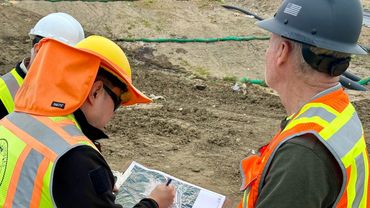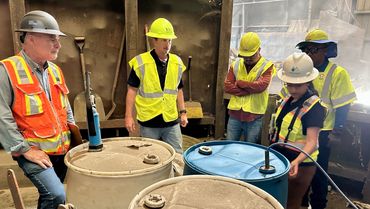THE LIVING EARTH FOUNDATION
Healing the Planet from the Ground Up!
The Living Earth Foundation is a 501c3 nonprofit research and educational organization that
specializes in the ability of naturally occurring microbes to cleanse and detoxify contaminants,
which is commonly referred to a “bioremediation”. This is a relatively new biological science that
had its beginnings in 1969, when petroleum engineer, Dr. George M Robinson, prescribed a special
microbial formula that detoxified the massive oil spill off the coast of Santa Barbara in early 1969.
This probiotic inoculant turned the toxic crude oils into a harmless vegetable oil that the marine
life could consume as a healthy food source. As a result of this oil spill crisis, the US EPA was
formed, the Earth Day Festivals had their beginning, and the first environmental studies
school was initiated at UC Santa Barbara. Thus, what better place to launch a nonprofit
organization that specializes in bioremediation services for restoring the biological
health & resilience of contaminated sites impacted by the pervasiveness of toxic
chemicals than the ecologically progressive community of Santa Barbara?

THE BIOLOGICAL MITIGATION OF LANDFILL GREENHOUSE AND ODOROUS GASES
The Living Earth Foundation is currently providing bioremediation services in cooperation
with the City of Los Angeles and the owners of the Sunshine Canyon Landfill, Republic Services, to
test the efficacy of specialty probiotic inoculants designed to remediate harmful greenhouse and
odorous gas emissions. Our specialty toxin-consuming microbes are currently being applied to
the solid wastes at all of the landfill's transfer stations as well as directly onto the refuse being
deposited into the landfill. In addition, Living Earth is beginning to provide bioaugmentation
services at the completed grassland sections to establish microbial biofilters in the plant
root systems that help to remediate harmful greenhouse and odorous gas emissions.



ADVANCING MULTIPLE ENVIRONMENTAL RESTORATION PROJECTS
The landfill bioremediation project marks just the beginning of numerous environmental
restoration projects that cleansing microbes can successfully decontaminate. In addition, the
Living Earth Foundation will begin offering its bioremediation services in areas where there have
been early signs of success in fields where there are high demands for ecological restoration
which include: oil spills and red tide decontamination; wastewater treatment operations;
flood water decontamination; EPA Superfund cleanup projects; livestock, poultry, and
fishery health services; with a special emphasis for onsite agro-ecological training.






The greatest challenge of our time is addressing the root causes of the climate and environmental crises. Now, more than ever, we are experiencing a systematic breakdown of the ecosystems primarily due to the excessive use and release of harmful chemical compounds – of which conventional agri-cultural is one of the primary contributors. The imperative challenge, therefore, is discovering healthier, more productive ways of growing our foods in a manner that restores and replenishes our natural resources rather than depletes and contaminates them.
It is out of this challenge that a holistic and integrative approach to agriculture has emerged that is
termed “agroecology”, which is the application of ecological principles to agricultural systems and practices. The field of agroecology is a multidisciplinary scientific approach that integrates agronomy, ecology, environmental studies, biology, sociology, history, economics, and other fields of study.
According to the UN Food and Agriculture Organization, agroecology seeks to: 1) protect, restore, and improve the existing agricultural food systems in the face of climate change; 2) sustainably increase soil biodiversity as an integral part of achieving improved food production; 3) prevent land degradation and restore degraded soil areas; 4) produce higher volumes of food with fewer resources; 5) create sustainable and resilient food systems by optimizing the interactions between plants, animals, humans, and the environment; and 6) take into account quality-of-life factors that considers fair and humane working conditions, sustainable livelihoods, community engagement, and equitable food access.
In the field of agroecology, important climate-friendly breakthroughs are being made that outperform and outproduce conventional agrochemical practices that restore the biodiversity of the soil, reduce the input costs, detoxify the soil, improve the water holding capacity, and pulls airborne carbons back into the soil. What is needed is professional onsite specialists to work side-by-side with agrochemical farmers and ranchers to provide hands-on training and resources for quickly and profitably making a smooth transition to sustainable agroecological practices.
OUR PRIMARY OBJECTIVE, therefore, is to assist conventional farmers and ranchers in replacing highly impactful agrochemical dependencies with highly beneficial microbial systems that improve both the organic health of the ecosystems and the profitability of their agricultural operations. We seek to make these agroecological transitions AS QUICKLY AND PROFITABLE AS POSSIBLE!

HOW IT WORKS
A handful of healthy, living soil will contain billions of microbes. It should be noted that soils with an abundance of mineral nutrients - such as nitrogen, phosphorus, potassium, and calcium - would be completely sterile without the presence of microbes. It’s important that soils have BOTH, healthy amounts of nutrients and microbial life, for the plants to have optimum growth and productivity!
Most nutrients simply cannot be absorbed directly by the plant root systems. Microbes are able to digest and excrete many of these nutrients that the roots can absorb. They are so essential that the plants excrete nutrients through their root systems called “exudate” that attracts the microbes directly to the roots’ surface.
This creates a truly win/win, symbiotic relationship for both the plants and the microbes. Feeding the soil thus means restoring the beneficial microbes back into the topsoils and nourishing them with premium organic fertilizers so that the plants can thrive and flourish – and thereby produce the healthiest, most nutritious foods possible!
RESTORING THE SOIL'S HEALTHY MICROBIOME
A healthy soil microbiome is a diverse community of microorganisms that work together to promote plant growth, maintain soil fertility, and support a healthy ecosystem. The biological diversity of the microbiome is important, and a holistic approach is needed to improve soil health and crop productivity. It's a complex living system that resides primarily in the root systems or "rhizosphere" which include: bacteria, fungi, archaea, viruses, algae, nematodes, protozoa, arthropods, and earthworms – creating an interconnected biological soil food web.
The soil food web is integral to a healthy soil structure and, in turn, to growing healthy plants. As the soil organisms move, eat, grow, and die they cycle soil nutrients, suppress diseases in the soil, and improve water and air movement within the soil. Fungi, especially mycorrhizal fungi, play a crucial role in carbon sequestration due to their extensive hyphae network that can store large amounts of carbon from plant exudates. This is a key component for restoring airborne carbons back into the soil, which promotes a healthier agroecology for advancing a more productive climate-friendly agriculture.


In Drought-Stricken Times, by Restoring the Beneficial Microbes Back into the Soil It Improves the Absorbency and Water Holding Capacity Resulting in Sizable Water Savings as High as 50%

Organic Certification Requires a Three Year Chemical-Free Transition. With New Bioregenerative Systems, Most Growers Experience Sizable Yield Increases & Water Savings in the First Year!

Advanced MIcrobial Systems Assist
in Restoring the Natural Soil Biomes to
Provide Superior Insect, Weed, and Disease Resistance WITHOUT the
Addition of Toxic Agrochemicals

Learn Valuable Techniques when Recycling Green Wastes Producing Fungal Dominant Composts that will Rapidly Cleanse the Soil & Optimize
Airborne Carbon Sequestration

When the Soils are Revived and are Once Again Healthy, the Plants Thrive & Create Self-Regulating Systems that Resist Pests & Act to Strengthen
the Beneficial Pollinators

It's Important to Keep the Topsoils Thriving w/o Disrupting the Microbial Cultures from Tilling. Diversifying with Cover Crops Helps to Keep the Soil Healthy and Increase Revenues

Discover How to Steadily Boost the Diversity of the Soil Microbial Biomass and Thereby Increase the Fungal-to-Bacterial Ratios for Consistently Improving the Overall Fertility

The Widespread Use of Toxic Agro-chemicals has been Steadily Destroying the Microbial Cultures that Keep Airborne Carbons in Check. Our Agroecological Systems Work to Restore Them!
"Our farm was in serious trouble, but after implementing the soil food web approach we increased our yield by 150% in a single season. In addition, we were very successful to repeat this approach on different soils at different farms achieving excellent results. We also cut many input costs such as ferti-lizers by at least 60%. We continue to monitor and move our soils to a much better place, production continues to increase while many other benefits become apparent such as reduced disease, improved crop resistance to cold and/or heat, improved drainage, reduced soil salts along with better water holding capacity. It also improved the taste and has better shelf life."


"The soil food web approach is an effective and viable means of rapidly regenerating agricultural soils, enabling farmers to operate without the use of chemical inputs, thus protecting the world’s water-ways, insect, and animal populations. Restoring the soil food web to agricultural soils restores productivity and profitability to agriculture and results in substantial levels of carbon sequestration, and has the potential, if implemented on a global scale, to return atmospheric carbon to the safe level as identified by the Intergovernmental Panel on Climate Change."
Help Us to Restore Small Family Farms Like the Apricot Lane Farm
HELP US TO RESTORE THE FAMILY-OWNED FARMS!
Your contribution will help us to assist farmers shift to a
healthier, more productive way of growing organic foods.
We are Very Grateful for your Generosity.
